Educational Psychology Assignment: Chapter Summaries and Reflection
VerifiedAdded on 2022/09/06
|7
|1514
|27
Homework Assignment
AI Summary
This assignment summarizes key concepts from several chapters in an educational psychology textbook. Chapter 6 focuses on cultural diversity, including social class, ethnicity, and gender, and the concept of stereotypical threat. Chapter 7 introduces behavioral learning theories like contiguity, classical conditioning, and operant conditioning, emphasizing positive and negative reinforcement. Chapter 12 explores motivation, categorizing it into intrinsic and extrinsic forms, and discusses different motivational approaches. Chapter 13 covers creating effective learning environments, highlighting classroom management strategies, rules, and creating a positive learning community. Chapter 15 examines classroom assessment, grading, and standardized testing, including formative and summative assessments. The assignment also includes a reflection on how to apply these concepts in a future classroom setting.
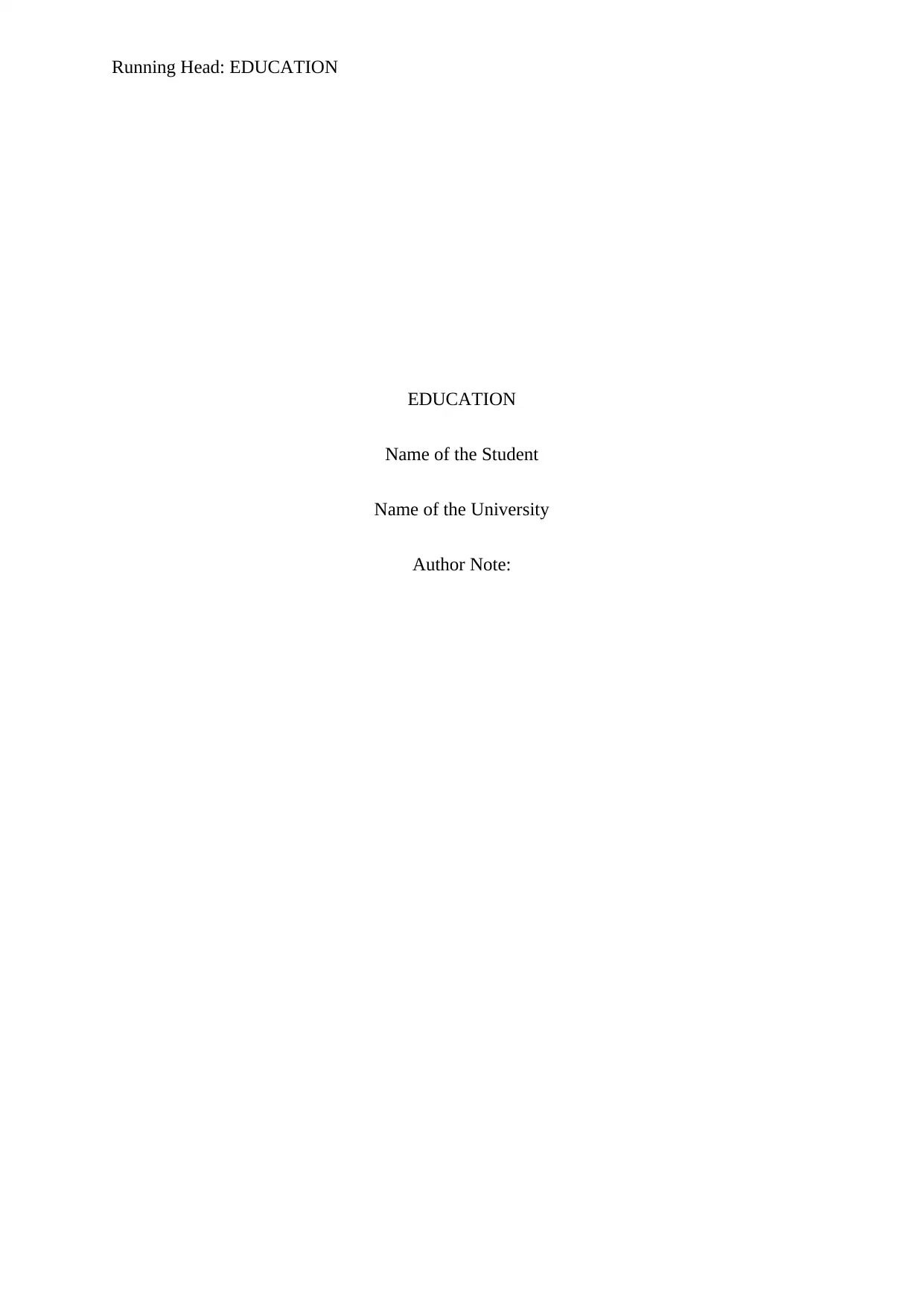
Running Head: EDUCATION
EDUCATION
Name of the Student
Name of the University
Author Note:
EDUCATION
Name of the Student
Name of the University
Author Note:
Paraphrase This Document
Need a fresh take? Get an instant paraphrase of this document with our AI Paraphraser
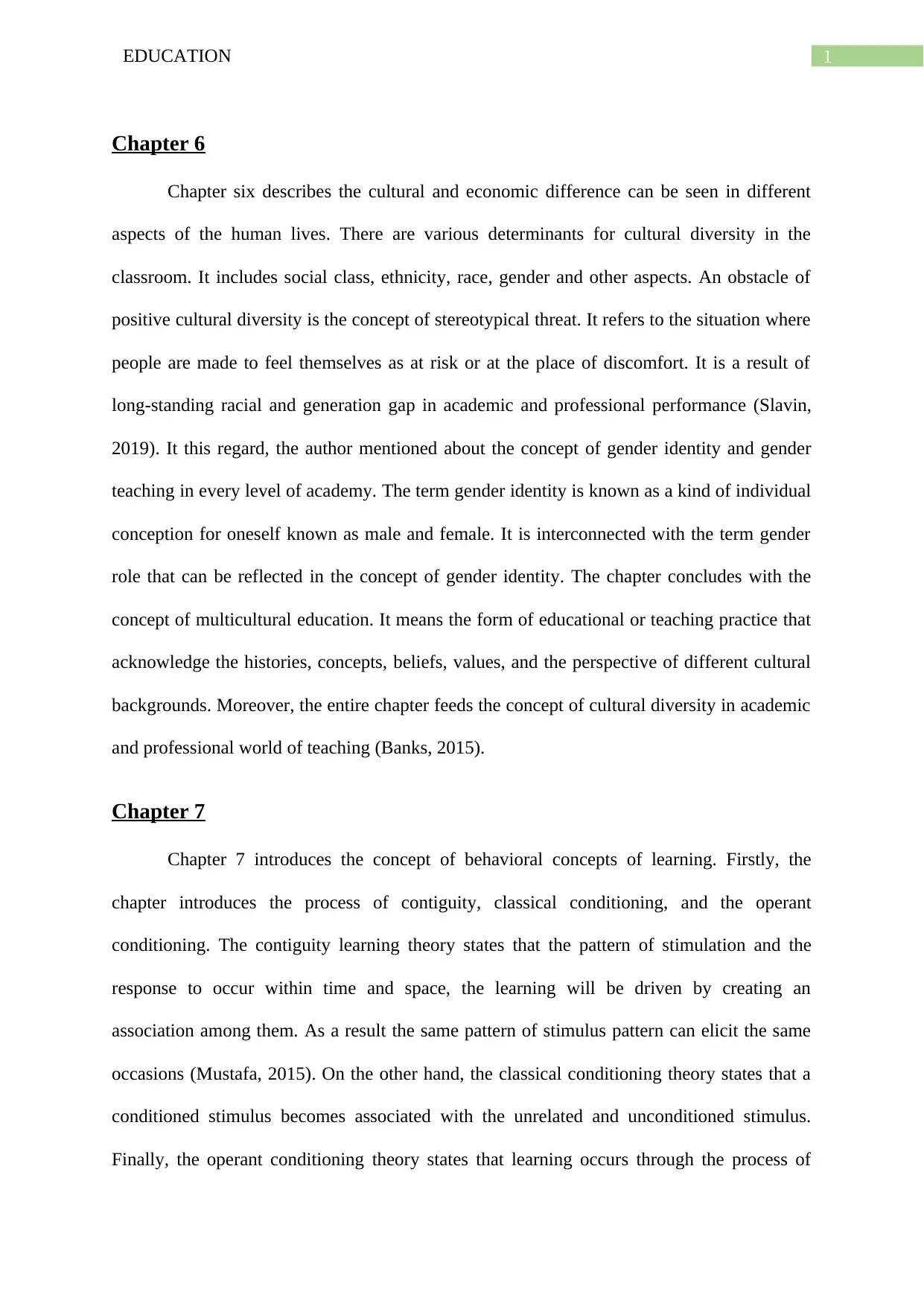
1EDUCATION
Chapter 6
Chapter six describes the cultural and economic difference can be seen in different
aspects of the human lives. There are various determinants for cultural diversity in the
classroom. It includes social class, ethnicity, race, gender and other aspects. An obstacle of
positive cultural diversity is the concept of stereotypical threat. It refers to the situation where
people are made to feel themselves as at risk or at the place of discomfort. It is a result of
long-standing racial and generation gap in academic and professional performance (Slavin,
2019). It this regard, the author mentioned about the concept of gender identity and gender
teaching in every level of academy. The term gender identity is known as a kind of individual
conception for oneself known as male and female. It is interconnected with the term gender
role that can be reflected in the concept of gender identity. The chapter concludes with the
concept of multicultural education. It means the form of educational or teaching practice that
acknowledge the histories, concepts, beliefs, values, and the perspective of different cultural
backgrounds. Moreover, the entire chapter feeds the concept of cultural diversity in academic
and professional world of teaching (Banks, 2015).
Chapter 7
Chapter 7 introduces the concept of behavioral concepts of learning. Firstly, the
chapter introduces the process of contiguity, classical conditioning, and the operant
conditioning. The contiguity learning theory states that the pattern of stimulation and the
response to occur within time and space, the learning will be driven by creating an
association among them. As a result the same pattern of stimulus pattern can elicit the same
occasions (Mustafa, 2015). On the other hand, the classical conditioning theory states that a
conditioned stimulus becomes associated with the unrelated and unconditioned stimulus.
Finally, the operant conditioning theory states that learning occurs through the process of
Chapter 6
Chapter six describes the cultural and economic difference can be seen in different
aspects of the human lives. There are various determinants for cultural diversity in the
classroom. It includes social class, ethnicity, race, gender and other aspects. An obstacle of
positive cultural diversity is the concept of stereotypical threat. It refers to the situation where
people are made to feel themselves as at risk or at the place of discomfort. It is a result of
long-standing racial and generation gap in academic and professional performance (Slavin,
2019). It this regard, the author mentioned about the concept of gender identity and gender
teaching in every level of academy. The term gender identity is known as a kind of individual
conception for oneself known as male and female. It is interconnected with the term gender
role that can be reflected in the concept of gender identity. The chapter concludes with the
concept of multicultural education. It means the form of educational or teaching practice that
acknowledge the histories, concepts, beliefs, values, and the perspective of different cultural
backgrounds. Moreover, the entire chapter feeds the concept of cultural diversity in academic
and professional world of teaching (Banks, 2015).
Chapter 7
Chapter 7 introduces the concept of behavioral concepts of learning. Firstly, the
chapter introduces the process of contiguity, classical conditioning, and the operant
conditioning. The contiguity learning theory states that the pattern of stimulation and the
response to occur within time and space, the learning will be driven by creating an
association among them. As a result the same pattern of stimulus pattern can elicit the same
occasions (Mustafa, 2015). On the other hand, the classical conditioning theory states that a
conditioned stimulus becomes associated with the unrelated and unconditioned stimulus.
Finally, the operant conditioning theory states that learning occurs through the process of
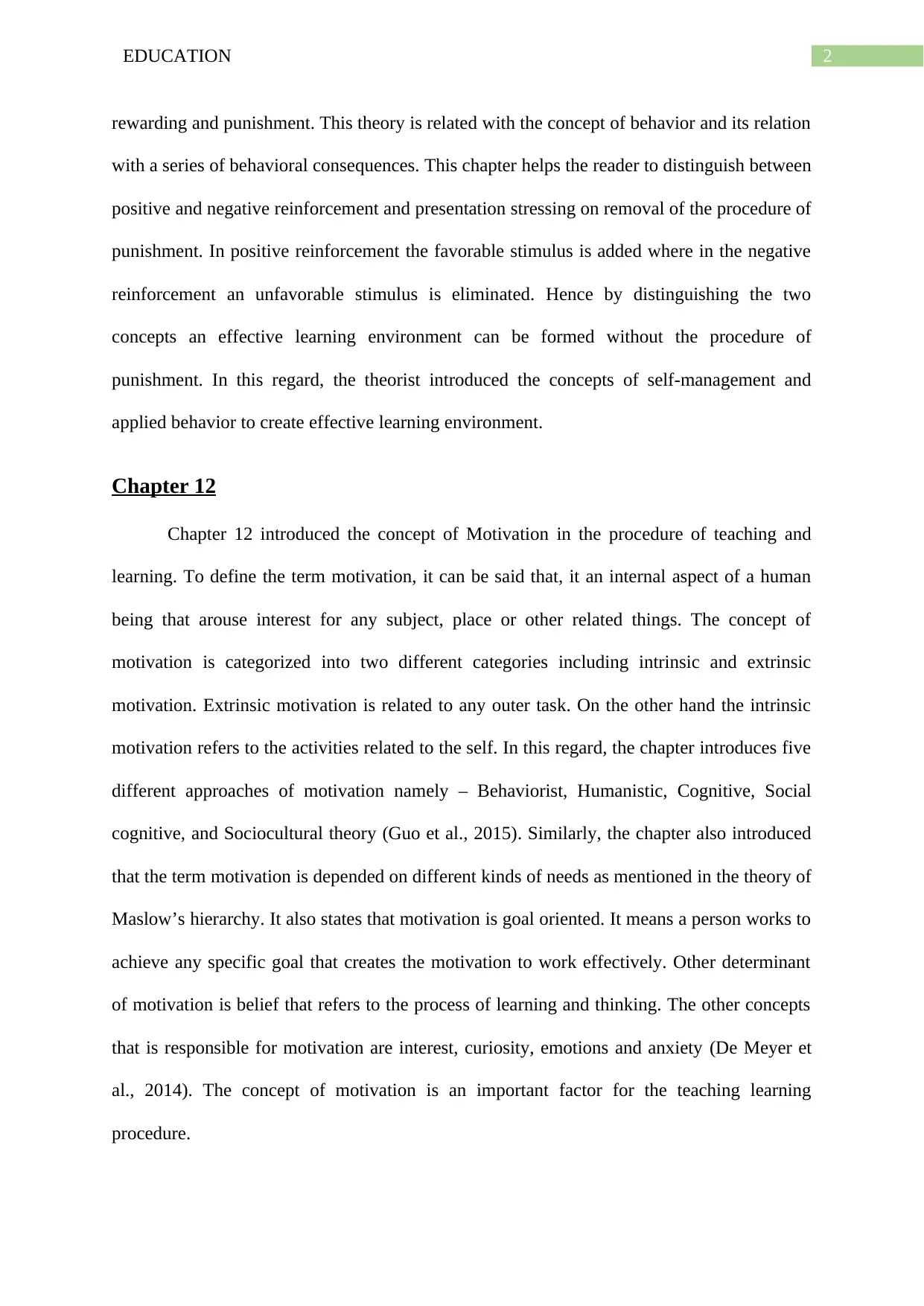
2EDUCATION
rewarding and punishment. This theory is related with the concept of behavior and its relation
with a series of behavioral consequences. This chapter helps the reader to distinguish between
positive and negative reinforcement and presentation stressing on removal of the procedure of
punishment. In positive reinforcement the favorable stimulus is added where in the negative
reinforcement an unfavorable stimulus is eliminated. Hence by distinguishing the two
concepts an effective learning environment can be formed without the procedure of
punishment. In this regard, the theorist introduced the concepts of self-management and
applied behavior to create effective learning environment.
Chapter 12
Chapter 12 introduced the concept of Motivation in the procedure of teaching and
learning. To define the term motivation, it can be said that, it an internal aspect of a human
being that arouse interest for any subject, place or other related things. The concept of
motivation is categorized into two different categories including intrinsic and extrinsic
motivation. Extrinsic motivation is related to any outer task. On the other hand the intrinsic
motivation refers to the activities related to the self. In this regard, the chapter introduces five
different approaches of motivation namely – Behaviorist, Humanistic, Cognitive, Social
cognitive, and Sociocultural theory (Guo et al., 2015). Similarly, the chapter also introduced
that the term motivation is depended on different kinds of needs as mentioned in the theory of
Maslow’s hierarchy. It also states that motivation is goal oriented. It means a person works to
achieve any specific goal that creates the motivation to work effectively. Other determinant
of motivation is belief that refers to the process of learning and thinking. The other concepts
that is responsible for motivation are interest, curiosity, emotions and anxiety (De Meyer et
al., 2014). The concept of motivation is an important factor for the teaching learning
procedure.
rewarding and punishment. This theory is related with the concept of behavior and its relation
with a series of behavioral consequences. This chapter helps the reader to distinguish between
positive and negative reinforcement and presentation stressing on removal of the procedure of
punishment. In positive reinforcement the favorable stimulus is added where in the negative
reinforcement an unfavorable stimulus is eliminated. Hence by distinguishing the two
concepts an effective learning environment can be formed without the procedure of
punishment. In this regard, the theorist introduced the concepts of self-management and
applied behavior to create effective learning environment.
Chapter 12
Chapter 12 introduced the concept of Motivation in the procedure of teaching and
learning. To define the term motivation, it can be said that, it an internal aspect of a human
being that arouse interest for any subject, place or other related things. The concept of
motivation is categorized into two different categories including intrinsic and extrinsic
motivation. Extrinsic motivation is related to any outer task. On the other hand the intrinsic
motivation refers to the activities related to the self. In this regard, the chapter introduces five
different approaches of motivation namely – Behaviorist, Humanistic, Cognitive, Social
cognitive, and Sociocultural theory (Guo et al., 2015). Similarly, the chapter also introduced
that the term motivation is depended on different kinds of needs as mentioned in the theory of
Maslow’s hierarchy. It also states that motivation is goal oriented. It means a person works to
achieve any specific goal that creates the motivation to work effectively. Other determinant
of motivation is belief that refers to the process of learning and thinking. The other concepts
that is responsible for motivation are interest, curiosity, emotions and anxiety (De Meyer et
al., 2014). The concept of motivation is an important factor for the teaching learning
procedure.
⊘ This is a preview!⊘
Do you want full access?
Subscribe today to unlock all pages.

Trusted by 1+ million students worldwide
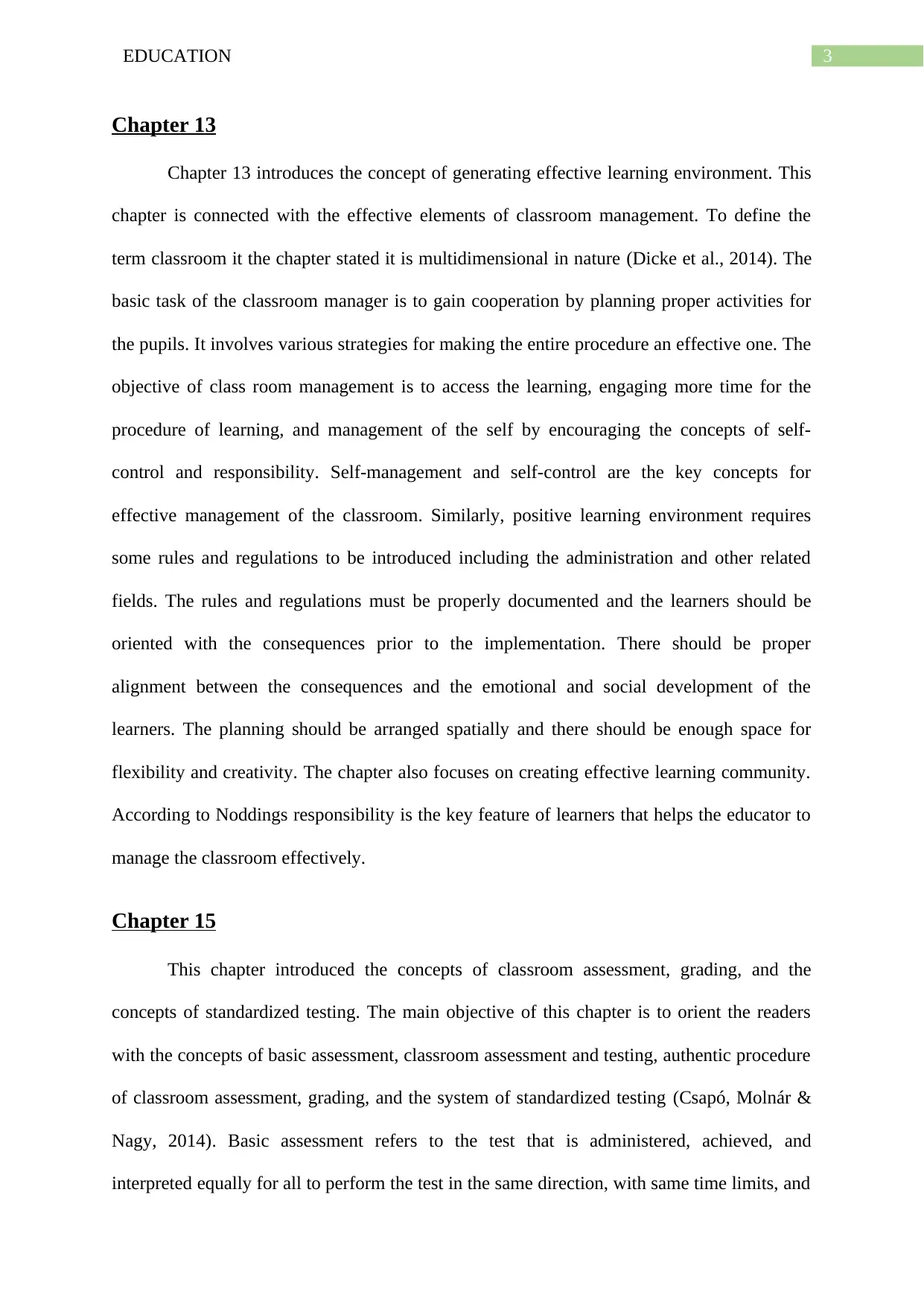
3EDUCATION
Chapter 13
Chapter 13 introduces the concept of generating effective learning environment. This
chapter is connected with the effective elements of classroom management. To define the
term classroom it the chapter stated it is multidimensional in nature (Dicke et al., 2014). The
basic task of the classroom manager is to gain cooperation by planning proper activities for
the pupils. It involves various strategies for making the entire procedure an effective one. The
objective of class room management is to access the learning, engaging more time for the
procedure of learning, and management of the self by encouraging the concepts of self-
control and responsibility. Self-management and self-control are the key concepts for
effective management of the classroom. Similarly, positive learning environment requires
some rules and regulations to be introduced including the administration and other related
fields. The rules and regulations must be properly documented and the learners should be
oriented with the consequences prior to the implementation. There should be proper
alignment between the consequences and the emotional and social development of the
learners. The planning should be arranged spatially and there should be enough space for
flexibility and creativity. The chapter also focuses on creating effective learning community.
According to Noddings responsibility is the key feature of learners that helps the educator to
manage the classroom effectively.
Chapter 15
This chapter introduced the concepts of classroom assessment, grading, and the
concepts of standardized testing. The main objective of this chapter is to orient the readers
with the concepts of basic assessment, classroom assessment and testing, authentic procedure
of classroom assessment, grading, and the system of standardized testing (Csapó, Molnár &
Nagy, 2014). Basic assessment refers to the test that is administered, achieved, and
interpreted equally for all to perform the test in the same direction, with same time limits, and
Chapter 13
Chapter 13 introduces the concept of generating effective learning environment. This
chapter is connected with the effective elements of classroom management. To define the
term classroom it the chapter stated it is multidimensional in nature (Dicke et al., 2014). The
basic task of the classroom manager is to gain cooperation by planning proper activities for
the pupils. It involves various strategies for making the entire procedure an effective one. The
objective of class room management is to access the learning, engaging more time for the
procedure of learning, and management of the self by encouraging the concepts of self-
control and responsibility. Self-management and self-control are the key concepts for
effective management of the classroom. Similarly, positive learning environment requires
some rules and regulations to be introduced including the administration and other related
fields. The rules and regulations must be properly documented and the learners should be
oriented with the consequences prior to the implementation. There should be proper
alignment between the consequences and the emotional and social development of the
learners. The planning should be arranged spatially and there should be enough space for
flexibility and creativity. The chapter also focuses on creating effective learning community.
According to Noddings responsibility is the key feature of learners that helps the educator to
manage the classroom effectively.
Chapter 15
This chapter introduced the concepts of classroom assessment, grading, and the
concepts of standardized testing. The main objective of this chapter is to orient the readers
with the concepts of basic assessment, classroom assessment and testing, authentic procedure
of classroom assessment, grading, and the system of standardized testing (Csapó, Molnár &
Nagy, 2014). Basic assessment refers to the test that is administered, achieved, and
interpreted equally for all to perform the test in the same direction, with same time limits, and
Paraphrase This Document
Need a fresh take? Get an instant paraphrase of this document with our AI Paraphraser
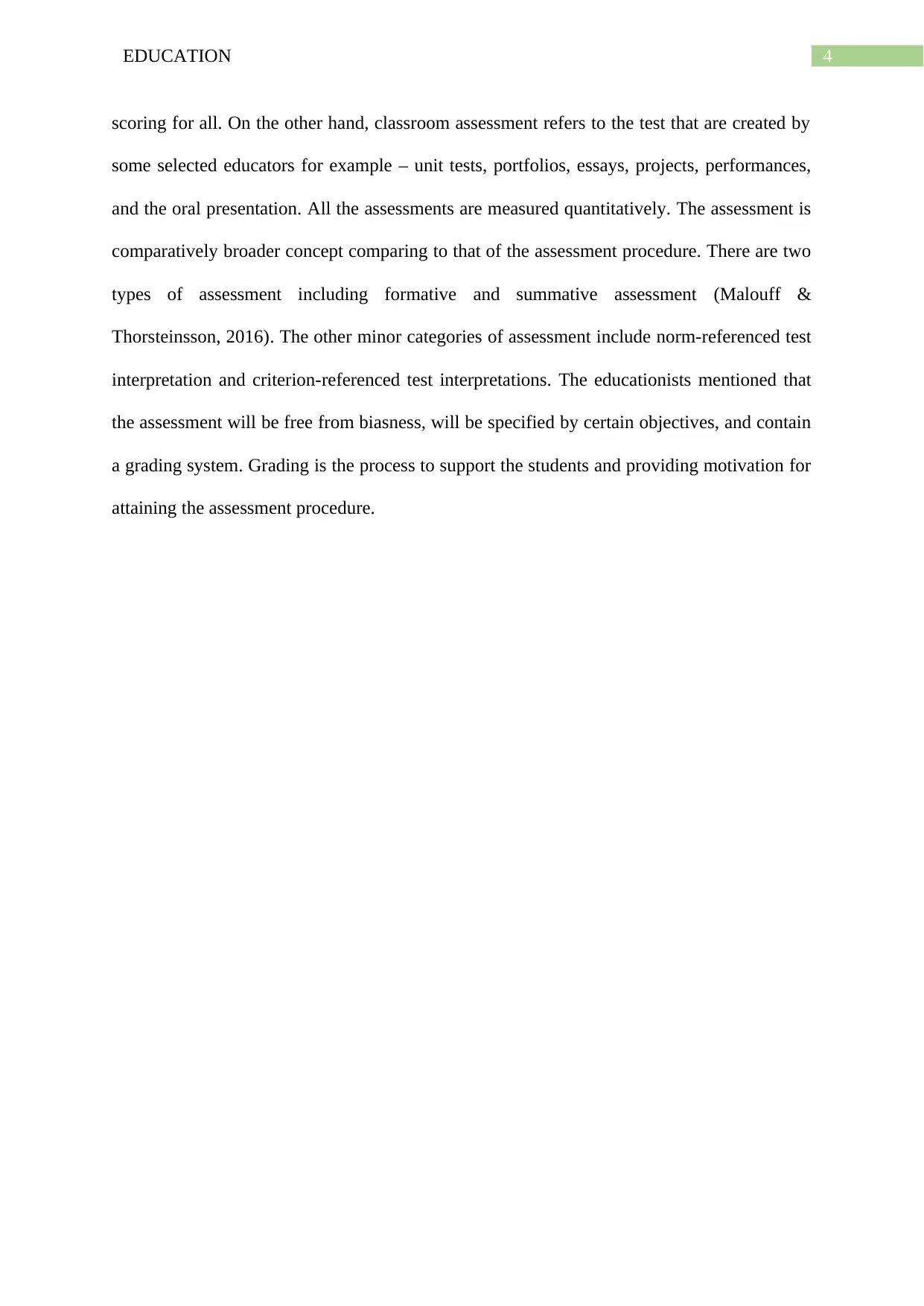
4EDUCATION
scoring for all. On the other hand, classroom assessment refers to the test that are created by
some selected educators for example – unit tests, portfolios, essays, projects, performances,
and the oral presentation. All the assessments are measured quantitatively. The assessment is
comparatively broader concept comparing to that of the assessment procedure. There are two
types of assessment including formative and summative assessment (Malouff &
Thorsteinsson, 2016). The other minor categories of assessment include norm-referenced test
interpretation and criterion-referenced test interpretations. The educationists mentioned that
the assessment will be free from biasness, will be specified by certain objectives, and contain
a grading system. Grading is the process to support the students and providing motivation for
attaining the assessment procedure.
scoring for all. On the other hand, classroom assessment refers to the test that are created by
some selected educators for example – unit tests, portfolios, essays, projects, performances,
and the oral presentation. All the assessments are measured quantitatively. The assessment is
comparatively broader concept comparing to that of the assessment procedure. There are two
types of assessment including formative and summative assessment (Malouff &
Thorsteinsson, 2016). The other minor categories of assessment include norm-referenced test
interpretation and criterion-referenced test interpretations. The educationists mentioned that
the assessment will be free from biasness, will be specified by certain objectives, and contain
a grading system. Grading is the process to support the students and providing motivation for
attaining the assessment procedure.
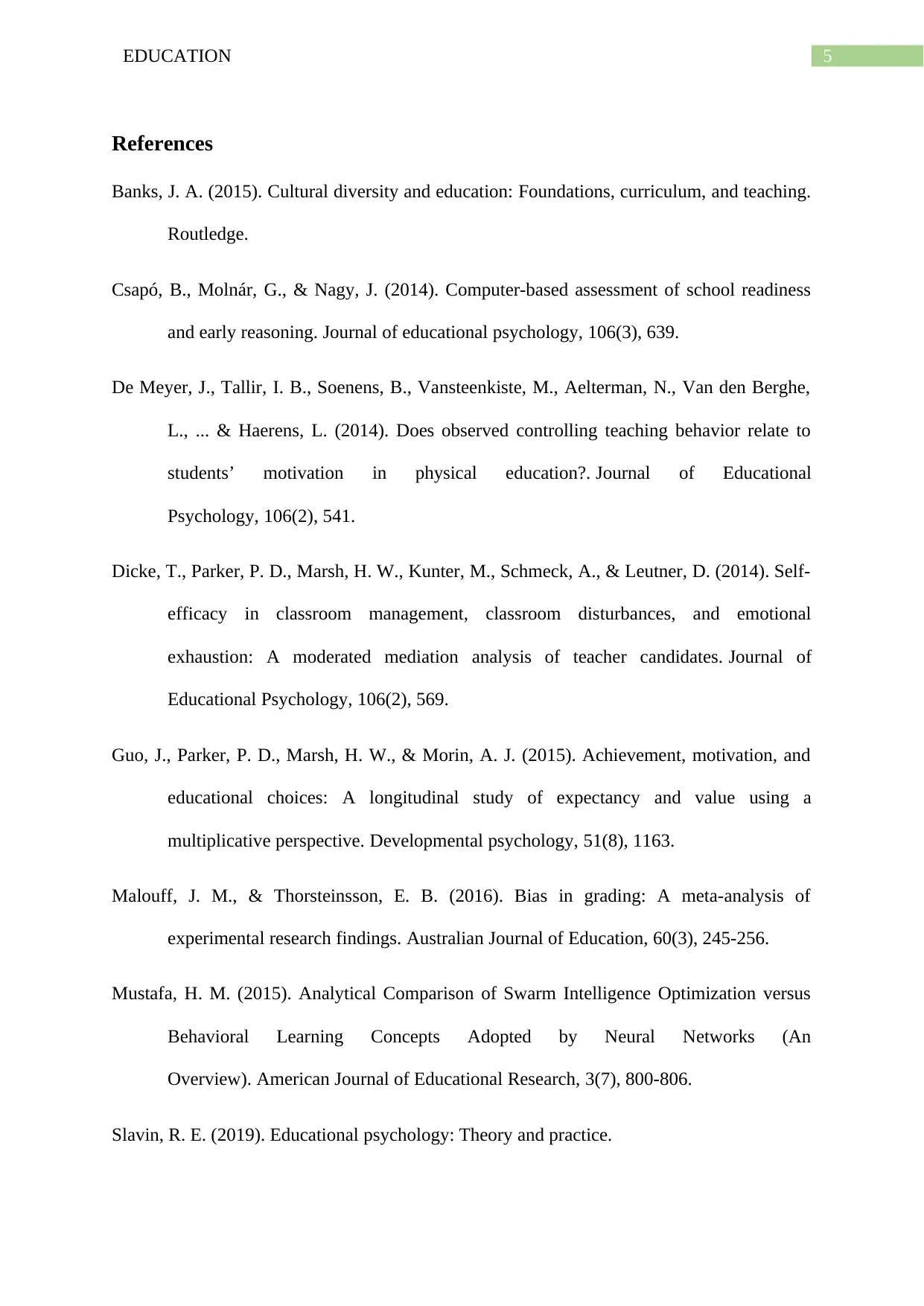
5EDUCATION
References
Banks, J. A. (2015). Cultural diversity and education: Foundations, curriculum, and teaching.
Routledge.
Csapó, B., Molnár, G., & Nagy, J. (2014). Computer-based assessment of school readiness
and early reasoning. Journal of educational psychology, 106(3), 639.
De Meyer, J., Tallir, I. B., Soenens, B., Vansteenkiste, M., Aelterman, N., Van den Berghe,
L., ... & Haerens, L. (2014). Does observed controlling teaching behavior relate to
students’ motivation in physical education?. Journal of Educational
Psychology, 106(2), 541.
Dicke, T., Parker, P. D., Marsh, H. W., Kunter, M., Schmeck, A., & Leutner, D. (2014). Self-
efficacy in classroom management, classroom disturbances, and emotional
exhaustion: A moderated mediation analysis of teacher candidates. Journal of
Educational Psychology, 106(2), 569.
Guo, J., Parker, P. D., Marsh, H. W., & Morin, A. J. (2015). Achievement, motivation, and
educational choices: A longitudinal study of expectancy and value using a
multiplicative perspective. Developmental psychology, 51(8), 1163.
Malouff, J. M., & Thorsteinsson, E. B. (2016). Bias in grading: A meta-analysis of
experimental research findings. Australian Journal of Education, 60(3), 245-256.
Mustafa, H. M. (2015). Analytical Comparison of Swarm Intelligence Optimization versus
Behavioral Learning Concepts Adopted by Neural Networks (An
Overview). American Journal of Educational Research, 3(7), 800-806.
Slavin, R. E. (2019). Educational psychology: Theory and practice.
References
Banks, J. A. (2015). Cultural diversity and education: Foundations, curriculum, and teaching.
Routledge.
Csapó, B., Molnár, G., & Nagy, J. (2014). Computer-based assessment of school readiness
and early reasoning. Journal of educational psychology, 106(3), 639.
De Meyer, J., Tallir, I. B., Soenens, B., Vansteenkiste, M., Aelterman, N., Van den Berghe,
L., ... & Haerens, L. (2014). Does observed controlling teaching behavior relate to
students’ motivation in physical education?. Journal of Educational
Psychology, 106(2), 541.
Dicke, T., Parker, P. D., Marsh, H. W., Kunter, M., Schmeck, A., & Leutner, D. (2014). Self-
efficacy in classroom management, classroom disturbances, and emotional
exhaustion: A moderated mediation analysis of teacher candidates. Journal of
Educational Psychology, 106(2), 569.
Guo, J., Parker, P. D., Marsh, H. W., & Morin, A. J. (2015). Achievement, motivation, and
educational choices: A longitudinal study of expectancy and value using a
multiplicative perspective. Developmental psychology, 51(8), 1163.
Malouff, J. M., & Thorsteinsson, E. B. (2016). Bias in grading: A meta-analysis of
experimental research findings. Australian Journal of Education, 60(3), 245-256.
Mustafa, H. M. (2015). Analytical Comparison of Swarm Intelligence Optimization versus
Behavioral Learning Concepts Adopted by Neural Networks (An
Overview). American Journal of Educational Research, 3(7), 800-806.
Slavin, R. E. (2019). Educational psychology: Theory and practice.
⊘ This is a preview!⊘
Do you want full access?
Subscribe today to unlock all pages.

Trusted by 1+ million students worldwide

6EDUCATION
1 out of 7
Related Documents
Your All-in-One AI-Powered Toolkit for Academic Success.
+13062052269
info@desklib.com
Available 24*7 on WhatsApp / Email
![[object Object]](/_next/static/media/star-bottom.7253800d.svg)
Unlock your academic potential
Copyright © 2020–2025 A2Z Services. All Rights Reserved. Developed and managed by ZUCOL.




